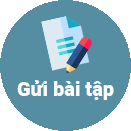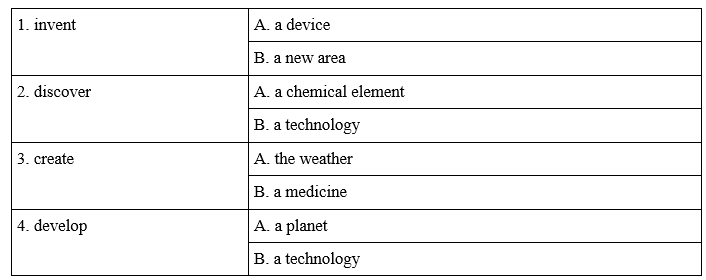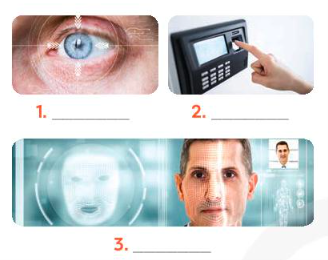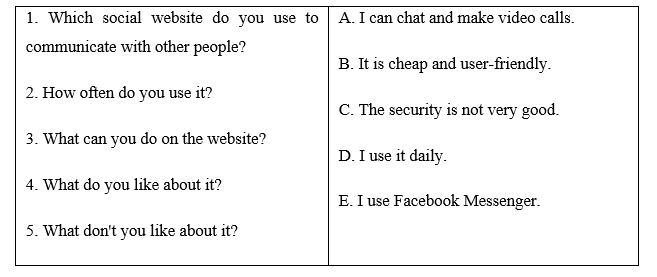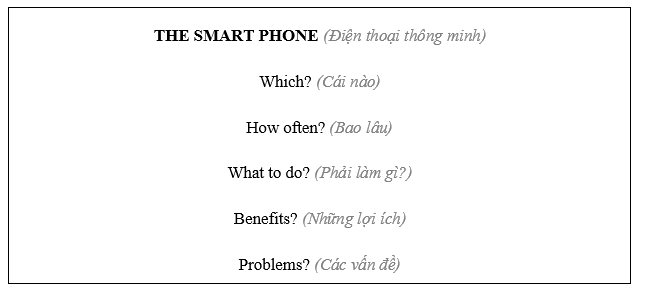Giải SGK, SBT Unit 11. Science and technology Global Success
Giải SGK, SBT Unit 11 Global Success
2. Read the conversation again and tick (✓) T (True) or F (False).
(Đọc đoạn hội thoại lần nữa và đánh dấu (✓) T (True) hoặc F (Sai).)
|
|
T |
F |
|
1. Ann and Minh had a face-to-face class yesterday. |
|
|
|
2. Ann likes face-to-face classes because she can interact with her classmates. |
|
|
|
3. Minh finds online classes inconvenient. |
|
|
|
4. When students use 3D contact lenses, their eyes will not get tired. |
|
|
|
5. Robot teachers will be able to mark papers and comment on student’s work. |
|
|
3. Label each picture with a phrase from the box.
(Dán nhãn cho mỗi bức tranh bằng một cụm từ trong hộp.)
|
3D contact lenses computer screen robot teacher breakout rooms online class Internet connection |


2. Read the texts and tick (v) B (Biometrics) or N (Nanolearning).
(Đọc văn bản và đánh dấu (v) B (Sinh trắc học) hoặc N (Nanolearning))
Biometrics
No more worries about truancy and cheating! Just introduce biometric applications at your school. With fingerprint scanners, or facial or voice recognition technologies, schools will be able to check students’ attendance. Teachers will no longer need to call students’ names to find out who is absent. This will make more time for activities!
Schools can also use these biometric applications for students who borrow books and equipment. Even more amazing, teachers can even use the eye-tracking applications to check students’ understanding of a lesson and to motivate students to learn.
For more information, visit www.biometricappsolution.com
Nanolearning
Tired of sitting in front of a computer all day long? Unable to concentrate for very long in your classes? Or frequently forgetting large amounts of information? The solution to these is Nanolearning created by Junglemap in 2006.
Nanolearning provides you with small amounts of information over a short period of time. Your learning will become effortless.
Believe us! Receive bits of information within two to five minutes via our platform, and you will increase your learning attention and ability. Our app also reports your study activities and results to your teacher.
Contact us at www.nanoleamingsolution.edu.com

2. Listen to the conversation and fill in each blank with ONE word.
(Nghe đoạn hội thoại và điền vào mỗi chỗ trống bằng MỘT từ.)
|
Things a robot teacher can do (Điều mà giáo viên người máy có thể làm) |
Things a robot teacher can’t do (Điều mà giáo viên người máy không thể làm) |
|
- Speak many (1) _________ - Tech languages, (2) ________, and many other subjects - (3) _______ with students |
- Teach students how to (4) ________ - Have emotional connections with students - Solve (5) _______ between students |
3. Listen again and tick (v) T (True) or F (False).
(Nghe lại và đánh dấu (v) T (True) hoặc F (False).)
|
|
T |
F |
|
1. Elias can do a Gangnam style dance. (Elias có thể nhảy điệu phong cách Gangnam.) |
|
|
|
2. Students can practise English with the robot in real time. (Học sinh có thể luyện tập tiếng Anh với rô bốt trong thời gian thực.) |
|
|
|
3. The robot feels tired when it repeats words. (Người máy cảm thấy mệt mỏi khi phải lặp lại từ ngữ.) |
|
|
|
4. The robot asks questions that are too difficult for students to answer. (Người máy hỏi câu hỏi quá khó để học sinh có thể trả lời.) |
|
|
|
5. Robots can teach students how to behave correctly. (Người máy có thể dạy học sinh cư xử đúng cách.) |
|
|
1. Circle the option that goes with each verb.
(Khoanh tròn phương án đi với mỗi động từ.)
|
1. create |
A. an application |
|
B. attendance |
|
|
2. invent |
A. a painting |
|
B. a telephone |
|
|
3. develop |
A. an art |
|
B. a technology |
|
|
4. discover |
A. a planet |
|
B. a technology |
2. Fill in each gap with a word or phrase from the box. You may have to change the form of the word or phrase.
(Điền vào mỗi khoảng trống với một từ hoặc cụm từ trong hộp. Bạn có thể phải thay đổi hình thức của từ hoặc cụm từ.)
|
eye-tracking application check attendance robot teacher face recognition |
1. They will develop more _____________ to support human teachers at schools.
2. Siri, the voice recognition technology, is a(n) ____________ of biometric technology.
3. Please look at this _____________ screen. It will check if you are a club member.
4. Teachers can ask students to wear _____________ glasses and check if they understand a lesson.
5. Schools can _______________ quickly and effectively using fingerprint scanners.
